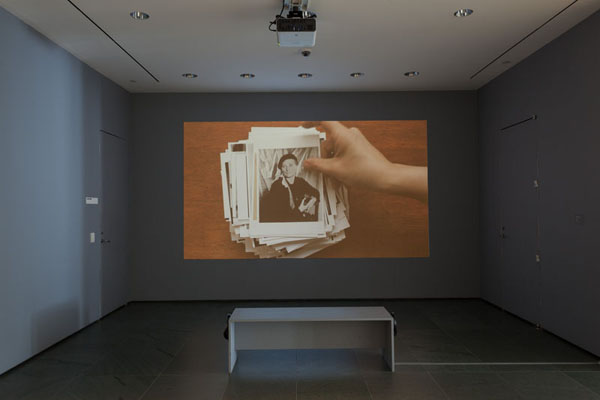WALID RAAD and ANDREA GEYER
by Phillip Griffith
WALID RAAD
OCTOBER 12, 2015 – JANUARY 31, 2016
ANDREA GEYER Insistence
THROUGH NOVEMBER 15, 2015
ANDREA GEYER Revolt, They Said
THROUGH NOVEMBER 29, 2015
MUSEUM OF MODERN ART, NEW YORK

Installation view, Andrea Geyer. Insistence. 2013. Video (color, sound). 15:21 min. The Museum of Modern Art, New York. The Modern Women’s Fund. ©2015 Andrea Geyer, courtesy Galerie Thomas Zander, Cologne. The Museum of Modern Art (October 16–November 15, 2015). Digital image © 2015 The Museum of Modern Art, New York. Photo: John Wronn.
On November 11, art historian Carrie Lambert-Beatty and artists Zoe Beloff and Katarina Burin gathered at the Graduate Center, CUNY, to discuss “Fabulated Archives.” Much of the conversation revolved around what Lambert-Beatty has termed “parafiction,” or art works that construct elaborate ruses to draw audiences into a fiction.1 At MoMA uptown, a survey of work by Walid Raad and a smaller pairing of two works by Andrea Geyer took on similar questions about what and how an archive can relate to its users.
Viewers familiar with Raad’s work will find well-known examples of the images, videos, and fictions about Lebanon’s civil war that he created under the collective moniker The Atlas Group (1989 – 2004). These works are no less exciting for their familiarity. With The Atlas Group, Raad produced works that loaded conceptual and affective heft into notions of the archive and, especially, the photograph.
The other series on view, Scratching on things I could disavow (ongoing since 2007), finds Raad still exploring modes of archival formation and presentation. The first part of the series, Walkthrough, staged on a platform in the atrium, is an archive that traces an institutional network in the time of its becoming, even ruminating self-reflexively on Raad’s work as The Atlas Group.
Unlike the work of The Atlas Group which purported to recover documents from Lebanon’s wartime history, Scratching. . . takes stock of the art world in the Middle East, as well as the dubious financial networks that support it, as it joins Western paradigms of museums, galleries, and biennials. Les Louvres, the archive that Raad proposes in the second part of Scratching. . ., assumes a projective power, as if objects put into close contact (here, those sent together from the Louvre’s collection of Islamic art objects to the museum’s new outpost in Abu Dhabi) might take on new identities—and demand new strategies for their own display.
This more recent work develops the importance of photographic logics to Raad’s conception (and fictionalization) of the archive. For example, Raad’s wall text for The Atlas Group’s Secrets in the open sea (1994 / 2004) claims that each monochromatic blue image in a series of photographic prints revealed an invisible, “latent” image of men found dead in the Mediterranean between 1975 and 1991 when subjected to further analysis. Reversing the terms of the photographic image as an index of reality, Raad imagines the image as an anti-index or abstraction that covers up an indexical truth.
In Les Louvres, Raad reports the fantastic transformation of one object into another after they touch in the process of being shipped to Abu Dhabi. In Raad’s words, they “trade skins” in a literal-minded reimagining of indexicality. Raad includes these objects in the installation, made with a 3D printer, the newest technology in our age of digital reproduction. This installation refuses the cultural translatability of the gallery space of a Western museum like the Louvre. As in Walkthrough, Raad suggests a confusion of terms in the misunderstandings, manipulations, and failures of cultural contact.
In a non-fictional register of archival intervention, Andrea Geyer’s video, Insistence (2013), represents the culmination of her research into the creation of MoMA by three women: Lillie P. Bliss, Mary Q. Sullivan, and Abby A. Rockefeller.On screen, the shot is filled by the plane of a wood tabletop where a disembodied hand begins stacking what appear to be postcards like those on sale at a museum. As the hand lays one postcard down on top of the previous one, Geyer narrates the lives of these and other women who intersect with their story. The images—portraits of these women, portraits of their lovers, reproductions of their artworks—cover each other in quick succession. The narration does not always match up to the visible image, but there are flashes when one of the images depicts the spoken description.
The postcards themselves hold a tenuous position vis-à-vis the archive. They are commercial reproductions that have not attained the status of archival document. Geyer proposes that her video offers not a revisionist history but rather, a manifesto for living and creating, and thus for recognizing the material contributions of these women to the world we live in today. Her postcards, then, suggest an archival inoperation. In the video’s narration, Geyer recounts how she was unable to find any letters written by Bliss, Sullivan, and Rockefeller to one another. An archivist informs her of what she and we surely could have guessed: women’s correspondence was so often historically devalued that the letters (if they existed, surely they did) were simply not considered important. Geyer’s archival research, then, ends in a sort of aporia, a black hole of those letters’ destruction. Geyer may not narrate a fiction in this video, but she tells us a story that circles the void of those women’s letters.
Geyer’s accompanying wall drawing Revolt, They Said (ongoing since 2012), presides over the museum’s stairway entrance. The drawing represents another effort at telling a story about women artists and cultural luminaries. Yet, this time, Geyer orients her work toward the past and revisionism, specifically of Alfred Barr’s 1936 diagram of the development of modern art. Geyer’s drawing reworks that vertically imagined historical account into a swirling, circular network of women. Geyer’s drawing, underscoring its resistance to Barr’s linear rationality, is illegible in its totality. Even climbing to the mezzanine overlooking the lobby, the upper reaches of the work are too small, too intricately detailed, too far away to make out.
As Beloff said during her presentation at the Graduate Center last month, “The archive is only there for us to activate and if we cannot it is nothing.” In Insistence and Revolt. . ., as well as Raad’s work, part of this archival story is missing, just out of view, though we can feel the pull of the materials we believe, wish, hope must be there. Just as the drawing is ongoing, so is the story, along with our desire to read and create it.
